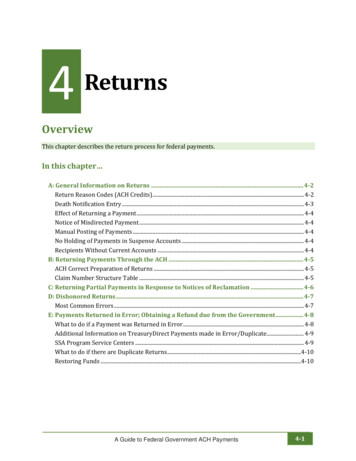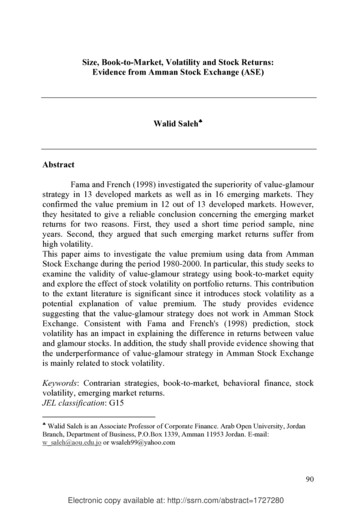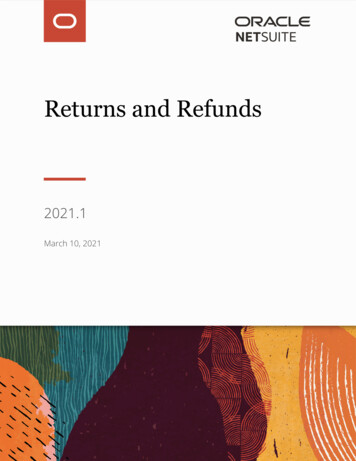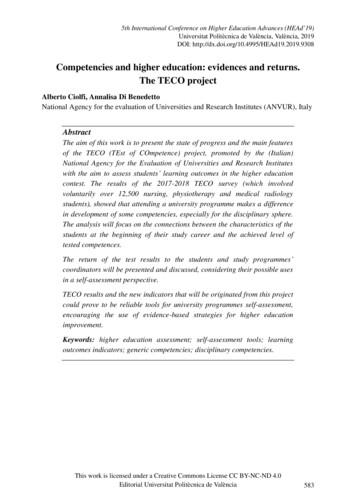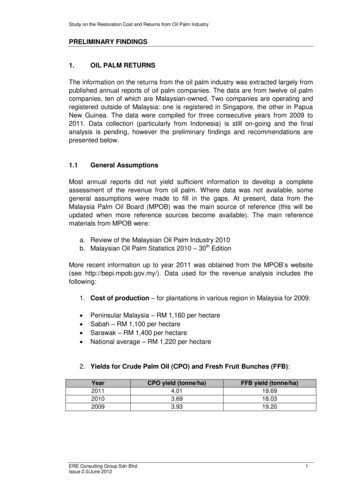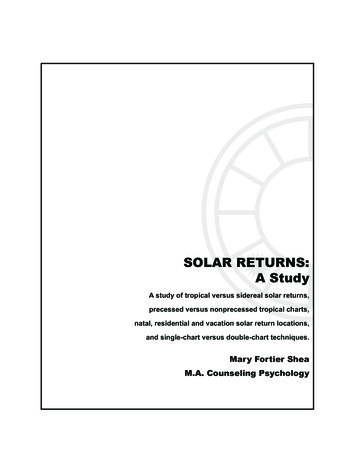
Transcription
SOLAR RETURNS:A StudyA study of tropical versus sidereal solar returns,precessed versus nonprecessed tropical charts,natal, residential and vacation solar return locations,and single-chart versus double-chart techniques.Mary Fortier SheaM.A. Counseling Psychology
This is a free e-bookletAlthough you are free to download this copy, pass it on to your friends, and share it withothers, I ask that you always retain the complete format including the copyright page andthe references to the author, the author’s contact information, and website.What you cannot do is reproduce this information for any publication without permission,nor can you attempt to claim this material as your own. This ebooklet is copyrighted and itdoes have an ISBN number for tracking and identification purposes.Please enjoy the information contained within. Learn from it and grow in your understanding of astrology. I have benefitted greatly from astrological teachings and I hope you dotoo.Cover designed by Mary Fortier Shea1-930310-01-3Printed in the United States of AmericaPublished by Twin Stars, UnlimitedMary Fortier SheaPO Box 301Clinton, CT .comCopyright - March 2000by Mary Fortier Shea
Other free material and e-booklets that can be found anddownloaded from www.maryshea.com/down.htmlSolar Return Frequently Asked QuestionsNine frequently asked questions about how to interpret Solar Returns charts.The Sun in the Solar ReturnBrief interpretations of the Solar Return Sun by house placement.The information includes the cycle of the Sun as it moves house tohouse in each consecutive year.The Star of DavidDescriptions of the Stars of David that have occurred in the skysince August 1, 1990 including the three War Stars, (one just beforethe Gulf War, the second immediately preceding the 9/11 attack onthe World Trade Center and the resulting war in Afghanistan, andthe third Star of David which led up to the war in Iraq. Informationof the next Star of David in 2011 is also presented.Making Choices with the Outer Planet Transits:Uranus, Neptune and PlutoIn this e-booklet is a discussion of the three outermost planets transiting in aspect to the five personal planets Sun, Moon, Mercury,Venus and Mars.A Step-by-Step Example of a Successful Electional ChartElectional charts are not just for weddings and corporations. In thisexample, the family wanted to immediately join a swim club witha two year waiting list. What seemed to be an impossible situationwas solved through electional astrology. Once the electional timewas chosen, the author worked with the elected chart in a co-creative manner. In doing so, the course of action and the outcomebecame clear.
SOLAR RETURNS:A study in the Sun’s return to its natal positionA wealth of information can be gained from a solar return chart. They are easy to interpret and givevaluable clues regarding major cycles of growth and transformation. Why then aren’t they a more popularastrological tool? Why aren’t they at least as popular as secondary progressions and transits?I believe that the solar return’s lack of astrological prominence is linked to the misunderstandingsand controversies surrounding their calculation and interpretation. In this booklet, I would like to addressthese issues, and try to dispel the confusion they bring. Specifically, I would like to discuss these topics anddilemmas:1. Tropical versus SiderealShould you calculate a tropical solar return chart or a sidereal one? What is the difference between the two and how would you interpret each kind.2. PrecessionWhat is precession and should you precess a tropical solar return chart?3. LocationWhich location do you use for calculating the chart? Place of birth? Residence? Presentlocation? And what happens if you are traveling?4. Single chart or double chart interpretation techniquesDo you interpret the solar return chart in reference to the natal chart or can it stand onit’s own? In using a two-chart technique, which chart goes in the center and which goeson the outside ring?
5SOLAR RETURNS: A studyOnce these and other questions concerning solar returns have been addressed, hopefully the readerwill have a clearer understanding of the choices available when calculating and interpreting solar returnscharts, and what each option is for. Clarity breeds insight and eventually solar returns will assume theirrightful place as a very valuable astrological tool.After addressing the issues mentioned above, I will demonstrate how I interpret solar returns andeffectively integrate their information with insights provided by transits and progressions. I will not begiving broad interpretations outside of the charts that I am interpreting since space is limited. For furtherinformation, I refer the reader to Planets in Solar Returns: Yearly Cycles of Transformation and Growth:Revised edition, (Twin Stars Unlimited, 1999, ISBN 0-9626626-8-2 ), which I wrote. In this book are detailed interpretations of the various planetary house positions in the solar return and further information onhow to interpret these charts. I cannot reproduce that information here and will limit my focus to the previously mentioned topics and goals.Definition of a solar return chartA solar return chart is a chart set for the exact time of the Sun’s return to its natal position. At themoment of birth, the transiting Sun has a very specific zodiacal position which can be defined in terms ofdegrees, minutes and seconds of arc. Each year the Sun returns to this exact natal position and the timeof the return can be calculated and known. This time is then used to calculate the solar return chart itself.(Calculations are difficult and for this reason, computer printouts are highly recommended. Age regressioncharts and logarithmic calculations do not work.) The time of the Sun’s return is hardly ever the birth timeand sometimes does not even occur on the birthday. The Sun may return a day or two before the birthday,the day of, or the day after. The yearly transit of the Sun through the zodiac is different from the 365 dailyrotations (days) experienced on earth during a year. There is approximately a 6 hour difference between thetwo. In other words, a true solar year (Sun’s yearly transiting time) is about 365.25 days long. We knowthis since it is the reason for February 29th, a leap day occurring every four years. The extra day correctsfor this discrepancy. Because of the difference between the true solar year (Sun’s transit) and the number ofdays in a year, the time of the Sun’s return advances approximately 6 hours each year, while dropping backa day every four years.Tropical or siderealWhen calculating solar returns, everything becomes a lot clearer if you remember not to mix applesand oranges. Astrology has been divided between the tropical and sidereal systems for a long time. Thepoints of reference for these two systems are very different. Solar returns are subject to the confusion associated with these two systems since one has the option of either calculating a tropical or a sidereal solarreturn chart. But regardless of method of calculation chosen, each solar return chart needs to be handledand interpreted in a manner which is consistent with the originating system and its customary interpretationtechniques.Tropical astrology is based on the relationship between the Sun and the earth, and the Sun’s apparent path projected on the earth’s surface (ecliptic). Twice a year, the Sun’s declination becomes zero asit crosses the equator. The northward crossing is called the Vernal Equinox, and is defined as the beginning of the zodiac or “0 degrees Aries.” The southward passage marks the Autumnal Equinox and defines“0 degrees Libra.” The maximum northern declination of the Sun is the Summer Solstice and “0 degrees
6SOLAR RETURNS: A studyCancer,” while the maximum southern declination of the Sun is the Winter Solstice and “0 degrees Capricorn.” Tropical systems are very earth-oriented and consistent with the change of seasons we experience.They have little to do with stellar placements and alignments, or the Precession of the Equinox (primarilya sidereal concern).Sidereal astrology is star based. “0 degrees Aries” is always associated with the beginning of theAries constellation formed by stars. Whenever the Sun is in this part of the stellar sky, in this constellation, it is in Aries, regardless of where the Sun falls in relationship to the equator or what time of year orseason it is here on earth. Because of the wobbling of the earth on its axis and the resulting Precession ofthe Equinox (which is 26,000 years long), sidereal timing shifts slightly every year and the gulf betweentropical “0 degrees Aries” and sidereal “0 degrees Aries” grows. Presently, the timing of the tropical Ariespoint differs from the timing of the sidereal Aries point by about a month.Because these two systems have such different points of reference, it seems logical to assume thattropical solar returns should be handled differently from sidereal ones. The solar return chart is basicallylike a temporary natal chart and can be treated as such. Therefore tropical solar returns could be interpretedlike any other tropical chart, and all tropical techniques such as Sabian symbols, fixed stars, asteroids,house placements and aspects should apply. On the other hand, sidereal solar returns could be interpretedlike any other sidereal chart, and all sidereal techniques would apply to them. The Universe is consistentand it makes sense that what works for one chart in a system will probably work for other charts within thesame system, calculated in the same manner, and intended for a similar purpose.Unfortunately in the history of solar returns, this is not what happened. Until recently, there hasbeen very little information available on solar return charts and the few books that have been publishedwere written almost exclusively by siderealists. However, the majority of astrologers in this country aretropical astrologers. It was easy to make the mistake of applying sidereal techniques to tropical charts. Toa certain extent this would work. The emphasis placed on foreground and background planets (proposed inthese books) is not totally foreign to tropical astrology, but its use is primarily emphasized in horary astrology, or in regards to planetary strength based on whether a planet was angular, succeedent, or cadent. Forthe most part, popular tropical astrology has traditionally dealt with the whole chart, all the planets, houses,signs, and aspects. Therefore, at first glance, it seems logical to look at the whole chart when interpretinga tropical solar return. We do not need to stand on our heads to interpret these charts or deviate from whatwe already know. Within this approach, the background 12th house planets would be every bit as importantas the foreground 1st house planets. Equal weight and interpretation would be given to each of the planetsin each of these houses.The same is true of sidereal solar returns. They should be interpreted with sidereal techniqueswhich may include, but are not limited to foreground-background interpretations and demi-solar returns.Please keep in mind that these sidereal techniques may not work well with tropical solar return charts, andtropical techniques may not suit sidereal solar returns.I will readily admit that I am not familiar with sidereal techniques. I am a tropical astrologer. WhenI first started studying solar returns back in the 1970’s, I ran into the problems facing many astrologerstoday. It was at that time that I played with both tropical and sidereal charts. I ultimately connected with
7SOLAR RETURNS: A studythe tropical solar return and saw many correlations between what my clients were telling me and what I wasseeing in the solar return chart itself. Some interpretations were so blatant, they could not be denied.For example, here is the solar return chart for a newly divorced woman named Debbie. She hadbeen married for at least ten years. During most of her marriage, she was very overweight and appearedunattractive since she did not care how she looked. She spent her time raising her children and rarely wentout. Finances changed and the family needed more money. Debbie was forced to go out and get a part-timejob at a local supermarket. She had felt very restricted by her husband for most of her marriage, and onceshe was out working, she made friends quickly. Slowly the weight began to come down. As Debbie beganto care for her appearance, a beautiful woman emerged. Her husband was very threatened by these changesin his wife and sought to control her even more. But by then she would have none of it and resisted alllimitations. Fighting broke out and Debbie eventually asked her husband to leave the house, then filed for adivorce. This solar return starts just as the divorce is final. Debbie is on her own raising two children. Beingalone and independent is a new experience for her since she wed right out of high school and went from herparent’s home to her marriage.As we look at the chart, the planetary placements seem very obvious. Note the emphasis on the 1sthouse and the need to do something “on your own, for yourself, and by yourself.” Both the Sun and theMoon are in the 1st house lending importance to this house. When both of the lights are in the same housein a solar return chart, this indicates that a new beginning is taking place according to that house position.In this case, there certainly was a new beginning for Debbie. When the Sun and the Moon are in the same
8SOLAR RETURNS: A studyhouse, but in different signs this indicates that the conscious urges and needs are different from the unconscious urges and needs. The individual may experience two very different sides of his or her personality.On one level, Debbie loved her freedom and wanted no limitations whatsoever. She was enjoyingherself and frequently went out wit
This time is then used to calculate the solar return chart itself. (Calculations are difficult and for this reason, computer printouts are highly recommended. Age regression charts and logarithmic calculations do not work.) The time of the Sun’s return is hardly ever the birth time and sometimes does not even occur on the birthday. The Sun may return a day or two before the birthday, the day .
